Warships. Cruisers. We stand the night, but hold out the day
Today, light cruisers of the British fleet type "Danae" or simply "D". They became a logical continuation of the C-series cruisers, one of the many in stories British fleet. Cruisers of the "Danae" type were intended primarily for operations against ships of the destroyer class and lighter, in the conditions of small water areas of the shooting range of the North or Mediterranean Seas. To combat the raider cruisers, which Germany was rich in, and even in the ocean, more powerful ships were required.
So, in order to solve various problems in coastal waters, already in 1916, the development of a light cruiser armed with six 152-mm guns began. The design of the Caledon-class light cruiser was taken as a basis, the hull of which was lengthened by 8,72 meters. This made it possible to comfortably place the sixth main battery gun.
The new cruiser differed from the "Caledon" in a large (430 tons) displacement, it became wider by almost a meter. But then the Battle of Jutland happened and the project was sent to be finalized in connection with the results obtained from this naval battle.
First of all, the ship armor system was improved, naturally, in the direction of increasing the thickness of the armor. In addition, the twin-tube torpedo tubes were replaced with three-tube ones, the width of the ship increased further, and, accordingly, the displacement increased to 5 tons. True, the estimated speed fell to 625 knots.
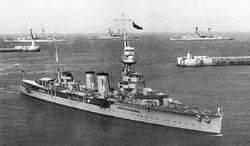
In the second and third series of D-type cruisers, changes were also made, as a result of which the ships "fat". But the problem of flooding the bow guns was solved by changing the bow, the fire control system was replaced with a newer one. Starting with the fourth ship of the series, the cruisers received a "trawler" type bow, which significantly improved seaworthiness and eliminated the flooding of bow guns.
Main design dimensions for the hull:
- total length along the hull: 143,6 m
- length between perpendiculars: 135,6 m
- maximum width: 13,9 m
- average draft: 4,3 m.
Reservation
Along the entire length of the hull of the ships along the waterline was an armored belt. The thickness of the belt in the area of engine and boiler rooms was 76 mm, fuel tanks and artillery cellars were covered with sheets 57 mm thick, in the stern the thickness of the armor decreased to 51 mm, in the nose - up to 38 mm.
Above the ammunition cellars and engine rooms, an armored deck 25 mm thick was located on top.
In addition, the artillery cellars had a “box-like” armor system, the walls and bottom of the cellars had armor plates 12,7 mm thick, and the top was armored with 25,4 mm thick plates.
The main caliber guns received shields 25,4 mm thick.
Power plant and driving performance
The power plant - two-shaft, steam-powered, consisted of six Yarrow steam boilers that produced steam for two Brown-Curtiss or Parsons turbo-gear units with a total capacity of 40 hp. Turbines through gearboxes rotated two propellers.
On trials, the cruiser accelerated to 29 knots without any problems. "Danae" in its tests with a displacement of 5 tons and a machine power of 500 hp. developed a maximum speed of 40 knots and became the fastest of the family. The slowest was the Diomed, which in the fall of 463 developed only 30,4 knots.
The range was provided by an oil reserve of 1 tons (maximum). This amount of oil was enough to cover 050 miles at 6 knots of cruising, or 700 miles at a maximum speed of 10 knots.
Crew and habitability
The crew according to the peacetime staffing of the project consisted of 450-452 people. On the cruisers, which were used as flagships, the crew grew to 470 people. In wartime, as air defense crews and radar posts grew, the number of people in the crew reached 620.
Living conditions did not stand out in any way from ships of the "C" type. Steam heating and forced ventilation of residential premises, showers, laundries, medical rooms.
weaponry
Main caliber
The main caliber of the cruisers were 152-mm Vickers Mark XII guns in single-gun mounts on central pin mounts. Loading was separate, manual. Manually, the guns were aimed in the horizontal and vertical planes.
The rate of fire of the guns directly depended on the training of the crew and could be 8-10 rounds per minute. The firing range is 17 km at an elevation angle of 30 degrees. Ammunition 200 rounds per barrel. Ammunition magazines were equipped individually for each gun.
The equipment of six artillery cellars of the Civil Code then caused a lot of controversy. On the one hand, more efforts were required to deliver shells and charges, on the other hand, the spirit of Jutland and the exploding battlecruisers of Britain hovered over all the ships of that time. We decided to follow this path, as far as it was justified - it is difficult to judge even today.
Auxiliary / anti-aircraft artillery
Universal artillery was represented by two 76-mm guns, which were mounted on single-gun anti-aircraft mounts HA Mk.II.
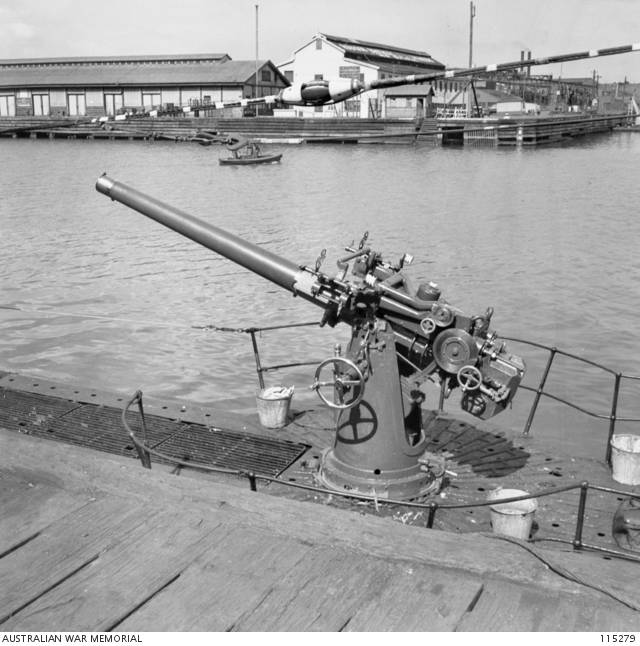
The installations were placed side by side, on both sides of the bow chimney. Ammunition was 300 high-explosive and shrapnel-type shells per gun.
In addition to this purely nominal armament, the cruisers were equipped with two 40-mm Vickers 2-pdr Mk.II guns with 800 rounds of ammunition per gun. The joint creation of Hiram Maxim and Torsten Nordenfeld was an enlarged Maxim machine gun with all the outgoing consequences.
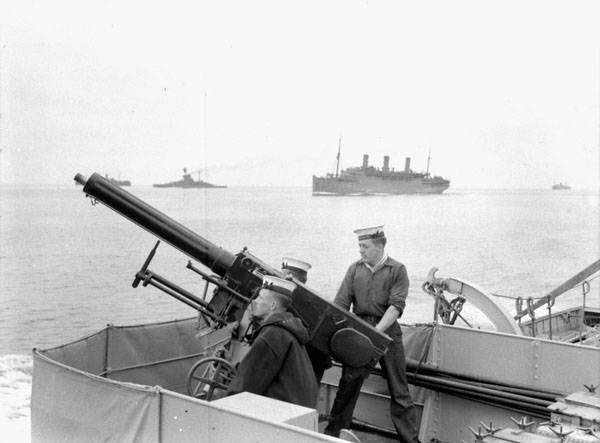
The last frontier of air defense was eight 7,7 mm Lewis machine guns.
In general, judging by the criteria for evaluating the First World War, anti-aircraft weapons were simply luxurious. If you measure by the standards of the Second - you yourself understand.
Torpedo armament
The torpedo armament of the ship was represented by four triple-tube deck-mounted 533-mm DRIII torpedo tubes, placed side by side on the upper deck. The ammunition was 12 D-type torpedoes, spare torpedoes were not provided.
Anti-submarine weapons
In the stern of each cruiser was a bomb releaser. It was installed in a very original way so that bombs could only be thrown on the port side, but the bomb release did not take up much space. 12 depth charges for that time were not god knows what weapons, but the cruiser was able to scare away the submarine.
Upgrades
Modernization was carried out very chaotically. The fact is that at the turn of 1930, the D-series cruisers were considered obsolete and they were decided to be converted into anti-submarine ships. But the war confused many plans, so the situation with modernization was peculiar.
To begin with, after 1930, instead of two 76-mm anti-aircraft guns, three 102-mm universal guns were installed, one in the stern and two on the side at the forward tube. This was the case on all ships, except for the Diomedes and Dispatch, these two 102-mm universals were originally installed.
"Danae" in 1939 received two more 40-mm "Pom-Poma".
In 1942, "Danae", "Dragon" and "Durban" lost single-barreled 102-mm guns and stern 152-mm guns of the main caliber. Instead, a 102-mm spark of a new model and two four-barreled 40-mm anti-aircraft guns from Vickers were mounted.
"Dauntless" in 1943 received two four-barreled 102-mm machine guns in their place instead of two onboard 40-mm guns.
"Diomed" in the same 1943 received a four-barreled 40-mm anti-aircraft gun instead of a stern 102-mm gun.
Since 1942, single-barreled 40-mm Vickers began to be removed on the D-series cruisers and 20-mm Oerlikons were installed instead. The number of 20-mm machine guns ranged from 8 to 10 and they were usually installed by the team at more or less suitable places for this.
During 1942-43, "Delhi", "Diomed", "Danae", "Dragon", "Dispatch" and "Dauntless" lost their torpedo tubes, instead of which anti-aircraft weapons were usually installed in the person of the same "Oerlikons".
"Dispatch" in 1944 was converted into an auxiliary ship. All 152-mm guns were removed and 16 single-barreled 40-mm machine guns from Bofors were installed.
Delhi underwent the most radical modernization in the United States in 1941-42. The entire set of weapons was completely removed, except for the 102-mm aft twins, and the following was installed instead: 5 universal 127-mm guns, 2 four-barreled 40-mm anti-aircraft guns from Bofors and 14 20-mm machine guns from Oerlikon. Plus the American fire control system.
Combat application
"Danae"
The cruiser "Danae" became part of the British Navy on June 18, 1918, when in the First World War everything was already clear and understandable. So until the end of the war, the cruiser did not take part in the hostilities, patrolling the passages in the minefields in the Baltic. Then he was engaged in routine service in the Mediterranean and East China Seas.
In 1936 he was withdrawn to the reserve, but in 1937 he was withdrawn from the reserve to participate in the Sino-Japanese War. Evacuated British citizens from Shanghai.
In the summer of 1939 he was assigned to the South Atlantic Station. He took part in the search for "Admiral Count Spee".
In 1940, he became part of the "Malaysian Forces", based in Singapore, engaged mainly in escort service to escort allied ships.
On February 3, 1942, the convoy BM.12, consisting of five transport ships and a tanker, left Batavia (Jakarta) for Singapore. The convoy was guarded by the cruiser Danae and two destroyers. As a result of the actions of the Japanese aviation four transports were sunk near the Ling archipelago, the Japanese finished off the fifth transport right in the harbor of Singapore. The tanker was damaged, drifted into a minefield, exploded and sank. "Danae" received no damage ...
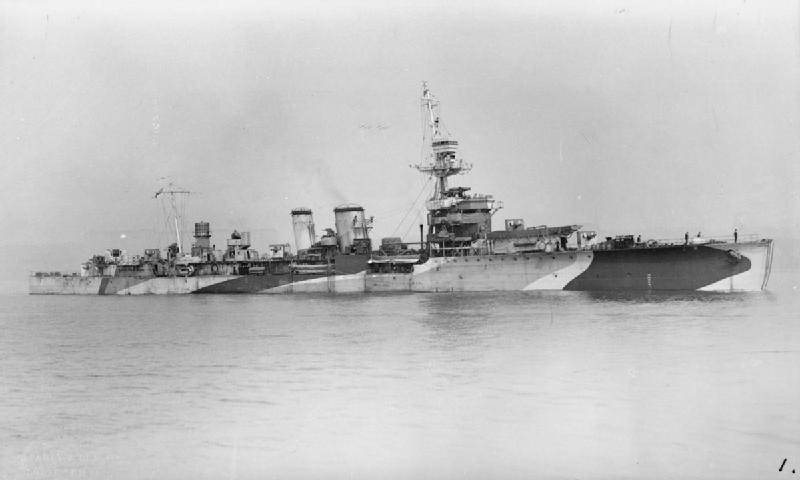
Further, the cruiser was included in the Western Assault Force along with the Dragon and Hobart cruisers (Australian) and two British destroyers. The ships repeatedly went out to search for the enemy, but to no avail.
As a result, "Danae" was transferred to the detachment for obsolete and slow-moving ships "Force B", and then sent to carry out escort duty off the coast of East Africa. The Danae served in the Indian Ocean until March 1944, then was recalled to the mother country and took part in preparations for the landing in Normandy.
On June 2, the group, which included Danae, left the mouth of the Clyde River, and on June 4 arrived at the agreed position "Z" off the northern coast of France in the English Channel. On June 6, 1944, Danae supported the landing in the Sword sector and the Juno sector with artillery.
Immediately after the successful landing of troops in Normandy, he was put into reserve.
In early September 1944, the command of the Polish Navy sent a request to the British Admiralty to provide a replacement for the lost light cruiser Dragon from the Admiralty reserve. In October 1944, Danae was transferred to the Polish Navy and renamed Konrad.
As part of the Polish Navy, "Konrad" served until 1946, after which he was transferred back and enrolled in the composition under the former name "Danae". In 1948, the cruiser was withdrawn from the fleet and sold for cutting into metal.
"Fearless"
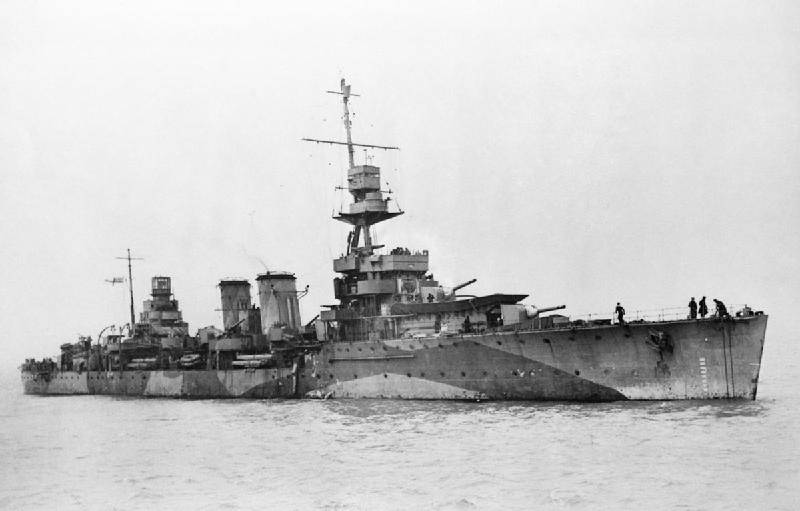
With the outbreak of World War II, Dountless met cruisers from the South Atlantic Command as part of the 9th squadron. In December, the squadron was transferred to the Chinese station, and in March 1940, Fearless acted in the interests of the British command in Malaya, operating in the Indian Ocean. Basically, the cruiser carried out reconnaissance service off the coast of Batavia, watching German merchant ships in the ports of the Dutch East Indies. On June 15, 1941, Fearless collided with the cruiser Emerald off the coast of Malacca and was sent to Singapore for repairs, which lasted until the end of the summer.
In February 1942, Fearless returned to the UK and underwent modernization at Portsmouth. After that, the cruiser was introduced into the Eastern Fleet, and in November 1942 the ship was sent to Simonstown, South Africa, where she carried out patrol service until January 1943.
In 1944, the military service of the cruiser was completed and it was used as a training ship. In February 1946, Fearless was sent for scrapping.
"The Dragon"
This cruiser managed to fight in the First World War as part of the Baltic squadron. He took part in battles with Russian forces in the Baltic. On October 17, 1919, during a duel with a coastal battery, three shells hit the cruiser. One 152-mm gun was destroyed, 9 people were killed, 4 more were wounded.
After the end of the First World War and the intervention, he was sent to the reserve, where he stayed until 1939, when he was manned by a crew of reservists and again enlisted in the Royal Navy of Great Britain.
At the beginning of World War II, the Dragon was in a detachment of ships that was engaged in the search for and interception of the German heavy raiders Admiral Count Spee and Deutschland.
After the surrender of France in 1940, the cruiser was transferred to Freetown in Sierra Leone, becoming part of the "Compound M". In September of the same year, he took part in the unsuccessful landing in Dakar, during which on September 23, 1940 he was lightly damaged by a French coastal battery.
Operating from Fritanun, he took part in the hunt for the German heavy cruiser Admiral Scheer, but without success.
At the end of 1941, the cruiser was transferred to Singapore, where she served with the battleship Prince of Wales and the battlecruiser Repulse in Force Z. In the battle of Kuantan, in which Compound Z took part, the cruiser, along with the Danae cruiser of the same type, did not take part due to low speed. After the destruction of the battleship and the battlecruiser by Japanese aircraft, the "Dragon" was engaged in the protection of military convoys cruising between the metropolis and the Far East.
During the battle in the Java Sea, the cruiser, along with other slow-moving ships, guarded the waters around Sumatra. After the heavy defeat of the allies in the Java Sea, he was transferred to Ceylon, where he spent most of 1942, carrying out patrol duty.
At the end of 1942, the ship went to the UK for repairs, after which it was handed over to the Polish Navy on January 15, 1943, manned by a Polish crew and the Polish flag was hoisted on it.
After training and coordinating the crew, the cruiser, which was left with its former name, took part in the landing of troops in Normandy. On June 6, 1944, the cruiser supported the landing, conducting a counter-battery fight with the enemy. The gunners of the cruiser destroyed a battery of 105-mm guns near Calville, suppressed a battery of 155-mm guns near Trouville and destroyed 6 tanks from the 22nd regiment of the 21st tank division. Within three days, the "Dragon" fired more than 1200 shells at the Germans with the main caliber. On June 18, the Dragon left for Portsmouth for minor repairs, and on July 7 headed back to the coast of France.
On July 8, 1944, the Dragon was spotted by the operator of the German human-guided torpedo of the Neger type, Karl Pottast, who was able to take a position 400 meters from the Polish cruiser, mistaking it for a large destroyer.
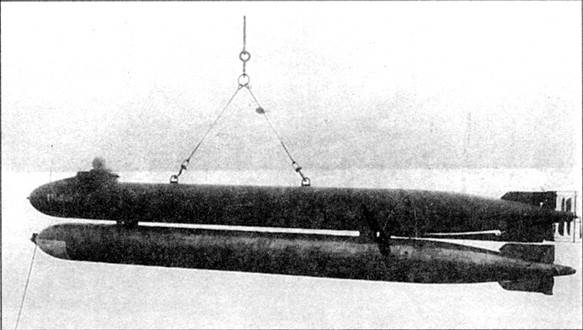
The torpedo hit the target at 4:40 am, about 20 minutes before the ship was due to open fire. The explosion almost completely destroyed the engine room along with all the servants, several sailors died in the artillery cellar, several anti-aircraft gunners were thrown overboard. The cruiser immediately began to roll to the port side.
As a result of the torpedo hit, the engine room was practically destroyed, while 37 people died. Since the ship was badly damaged, the British command raised the question of the inexpediency of repairing the cruiser, arguing that it was also due to her advanced age. Therefore, the ship was towed to the temporary port of Mulberry, built for the needs of the Allied Expeditionary Force near Caen.
"Dragon" was supposed to be flooded in order to be used later as a breakwater. On July 20, 1944, the Dragon was sunk and became part of an artificial breakwater along with other ships sunk there.
"Delhi"
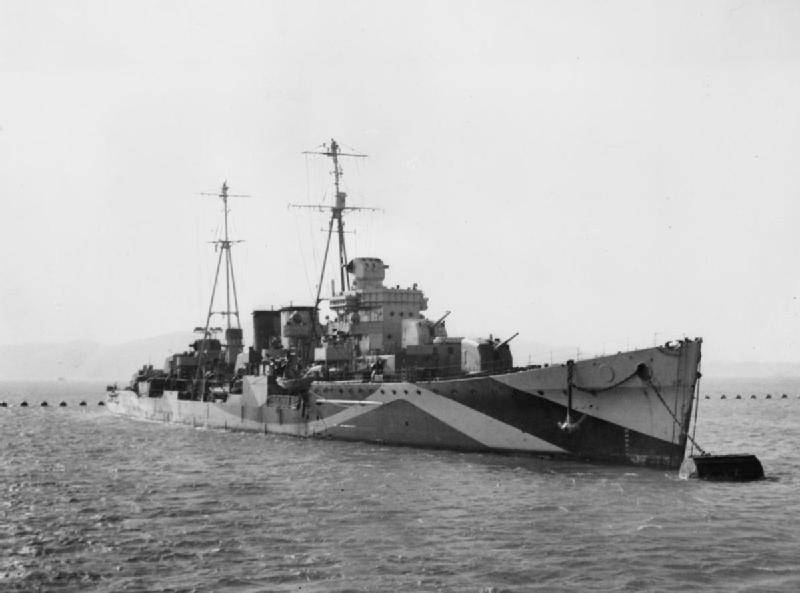
Participant of the intervention in Soviet Russia in the Baltic. He spent three years in the Atlantic Fleet, in 1925 he was transferred to the Mediterranean Sea, from where he made a voyage together with the Australian cruisers Adelaide and Sydney. In 1933 he again ended up in the Mediterranean.
When the Spanish Civil War began, "Delhi" was engaged in the evacuation of refugees from Palma de Mallorca, Barcelona and Valencia. During these operations, the Delhi was attacked by the heavy cruiser Canarias, which belonged to the Spanish Nationalists, came under heavy fire, and also suffered from air attacks.
After the repair, the cruiser went to the reserve, where he stayed until 1939. Further, the cruiser was again put into operation by the 11th cruiser squadron and sent to carry out the blockade of Germany. The Delhi team captured the German ship Reingold and sank the blockade breaker Mecklenburg.
Next was the search for the German battleships Scharnhorst and Gneisenau, which sank the auxiliary cruiser Rawalpindi along with the cruisers Caledon, Cardiff and Newcastle. However, the German battleships escaped.
In 1940, the Delhi took part in operations against the Vichy and Italian troops in North Africa, and then sent to patrol duty off the coast of West Africa in the South Atlantic.
In 1941, she was sent to the United States for repairs and modernization, where she was converted into an air defense cruiser. The main armament was 127 mm guns from the Edison destroyer. In its new capacity, Delhi provided cover for a number of landing operations in the Mediterranean. Algiers, Sicily, Salerno and landings at Anzio.
On November 20, 1942, in the Gulf of Algiers, the Delhi was damaged by an Italian bomb hitting the stern.
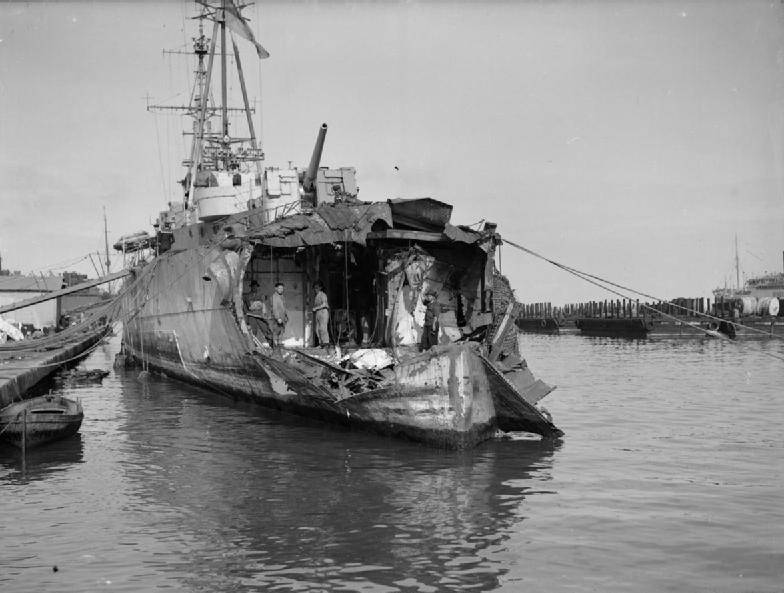
Two people were killed, the ship was sent to the UK for repairs. After repairs, in August 1943, the cruiser was returned to the Mediterranean.
On September 3, 1943, six days before the landing at Salerno, where the Delhi was supposed to cover the landing of troops, she collided with the cruiser Uganda in the Strait of Messina while laying a smoke screen. The repair was carried out by the crew and Delhi took part in the landing in Salerno.
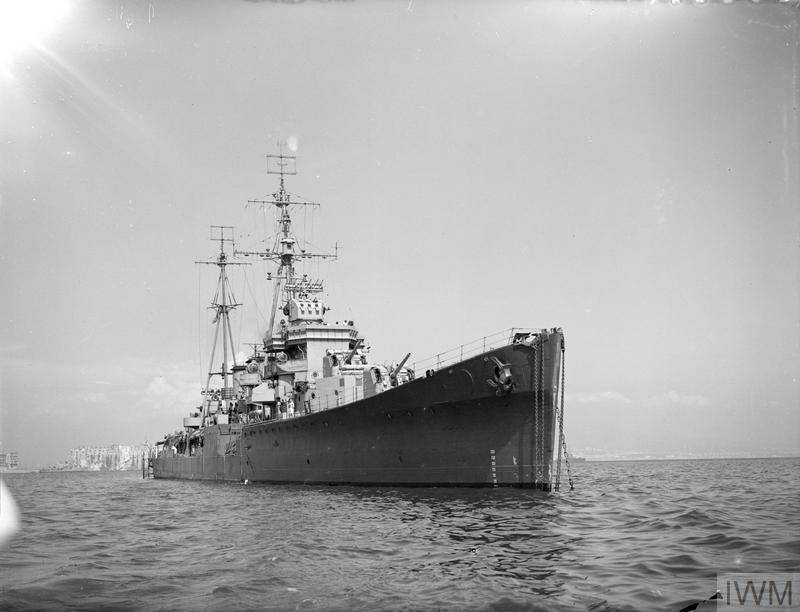
"Delhi" took part in the operation "Dragoon", the landing of troops in the south of France. Then the cruiser moved to Split, in Yugoslavia. There, on February 12, 1945, the Delhi was attacked by German bomb boats. The mined boats passed by the Delhi, but the force of the explosions damaged the rudder and one of the cruiser's propellers.
The cruiser returned to the mother country, but repairs and restoration were deemed inappropriate. In 1948, the cruiser was scrapped.
Dunedin
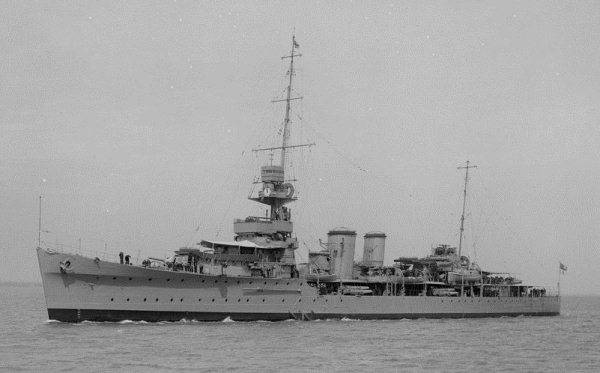
Named after a city in New Zealand, the cruiser entered service with the Atlantic Fleet. In 1923-24, as part of the New Zealand Division, he circumnavigated the world.
In 1935 she was assigned to the Mediterranean, where she was used as a training ship.
With the outbreak of World War II, the cruiser was commissioned and assigned to the 11th cruising squadron of the Home Fleet. The cruiser patrolled the Shetland and Orkney Islands, participated in the search for Scharnhorst and Gneisenau.
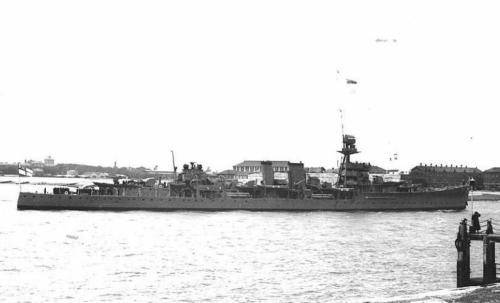
Patrol service in the North Atlantic continued until the end of 1939, and in early 1940 the Dunedin was assigned to the forces of the West Indies Naval Station. Together with the North Atlantic and South Atlantic stations, she was responsible for the security of communications in the Central and South Atlantic.
On March 2, 1940, the Dunedin stopped the German transport ship Heidelberg in the Windward Strait, but the Germans managed to open the kingstones and flood the ship even before the prize party arrived on board from the English cruiser.
On March 8, the German steamship Hannover was intercepted and stopped near the island of Haiti, which was sent to Great Britain with a prize batch, where it was rebuilt into the escort aircraft carrier Audacity.
On June 15, 1941, the cruiser captured the Lorraine tanker in the Central Atlantic, which provided the operations of German submarines in the Freetown area.
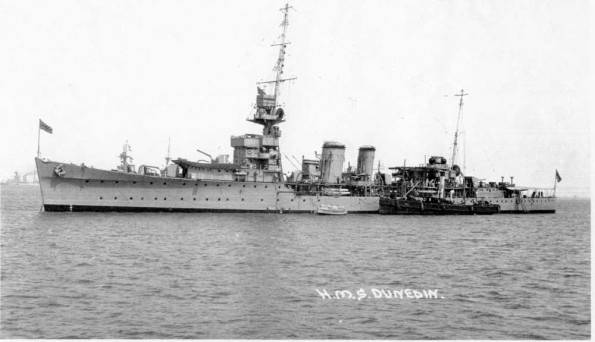
On June 30, east of St. Paul's Rock, the Dunedin detained the Vichy French steamer Ville de Tamatave, and on July 22, east of the Brazilian port of Natal, captured another French steamer, the Ville de Rouen.
On November 24, 1941, on the line of constant patrol in the Central Atlantic, north of Pernambuco, the cruiser was discovered by the German submarine U-124. The boat fired a two-torpedo salvo, both torpedoes hit the ship. Within half an hour, Dunedin sank, taking with her 26 officers and 392 sailors of the ship's crew. Only 67 people were saved.
"Durban"
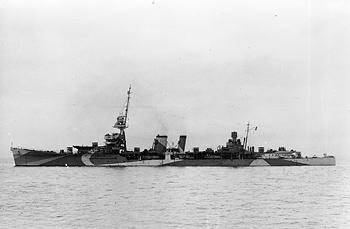
It was known for serving as Lieutenant of the Watch in the thirties Prince George, Duke of Kent, the fourth son of King George V and Queen Mary.
With the outbreak of World War II in September 1939, Durban ended up in the South Atlantic, then in the Indian Ocean, and finally at a base in Singapore. Here, during 1940-41, the cruiser carried out patrol and escort service, chasing the Atlantis raider (the Germans were able to escape). The main occupation is the escort of ships from Singapore to the Sunda Strait.
In February 1942, the Durban, along with the rest of the Eastern Fleet, moved to Java, after the Japanese launched an offensive against Singapore. The Durban in Singapore Harbor was damaged by bombing before she could get away, but on 12 February she and the ASW Kedah escorted merchant ships Empire Star and Gorgon from Singapore, repelling successive Japanese air attacks for four hours.
In Java, the Durban was patched up, after which the cruiser was sent to the USA for repairs, and then to the UK for modernization. After modernization, the cruiser was sent to escort convoys to South Africa.
In November 1943, the Durban ended up in the UK, where it was selected as an object of flooding to form a breakwater in the harbor of Mulberry, from where support for the troops landing in Normandy was to be carried out.
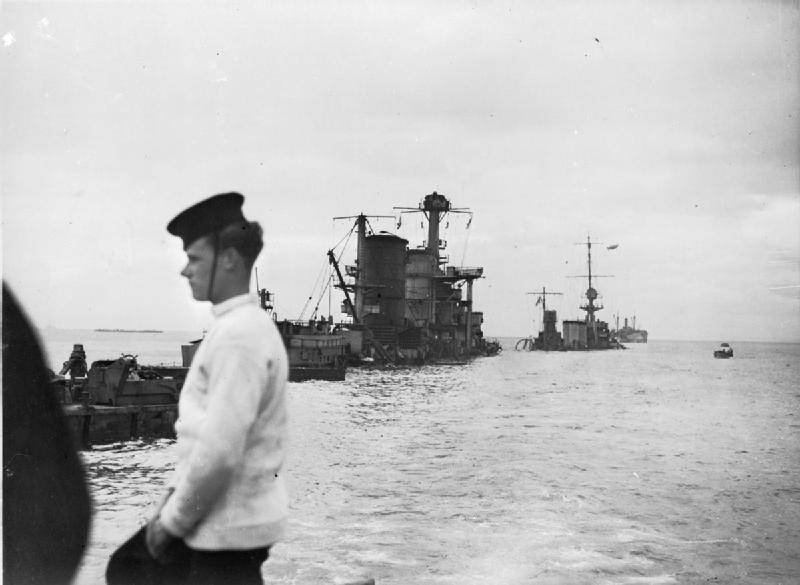
On June 9, the Durban was scuttled and became part of the artificial harbor of Ouistreham in the Gulf of the Seine.
"Dispatch"
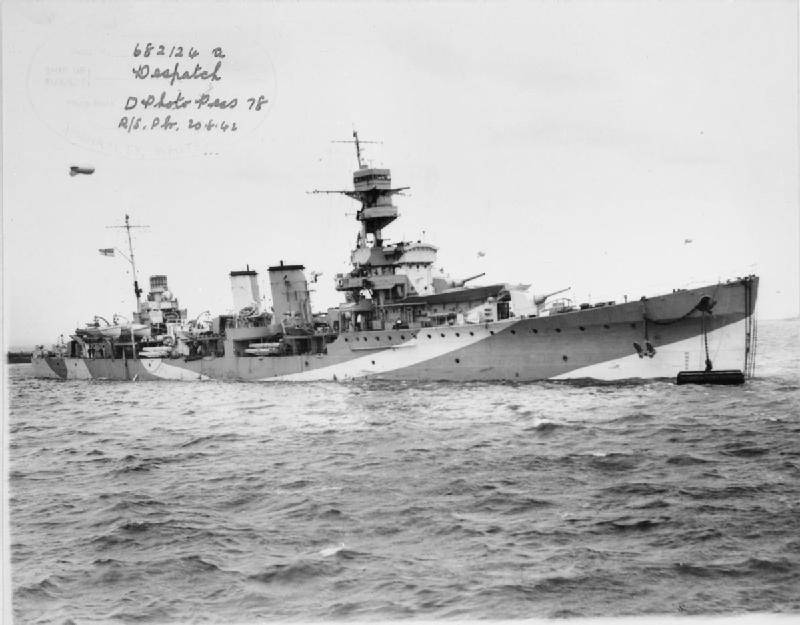
The Depeche had a relatively quiet military career compared to the Sister Ships. At the beginning of the war, the cruiser operated in the South Atlantic, where it hunted for German blockade breakers. The crew of the "Depeche" captured the ship "Düsseldorf" and intercepted the ship "Torya", the crew of which preferred to sink their ship.
In 1940, the cruiser was transferred to the Mediterranean Sea, where the Dispatch was engaged in escort service, which did not prevent the ship from taking part in the battle at Cape Spartivento.
In February 1943, Depeche captured the Spanish ship Monte Naranjo and sent it as a prize to Gibraltar.
In preparation for the landing operation in Normandy, Depeche was involved in the role of a command ship. For this, the main caliber guns were removed and 16 Bofors 40-mm caliber were installed.
The ship served as the air defense headquarters for the Mulberry area.
Depeche was put into reserve in January 1945 and sold on April 5, 1946 for scrapping.
"Diomed"
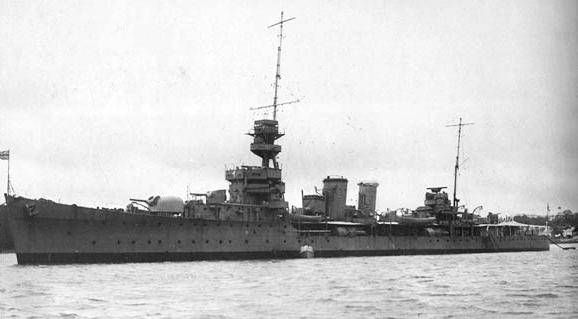
The combat service of the cruiser began in 1939 with the release from the reserve, in which the ship was for a very long time.
At the beginning of her career, in 1940, the cruiser was sent to work as an interceptor of blockade breakers. The result was the death of the German blockade breaker Idarveld, whose crew sank the ship.
Further, in 1942, followed by patrol service in the South Atlantic and escort of convoys from Great Britain to South Africa.
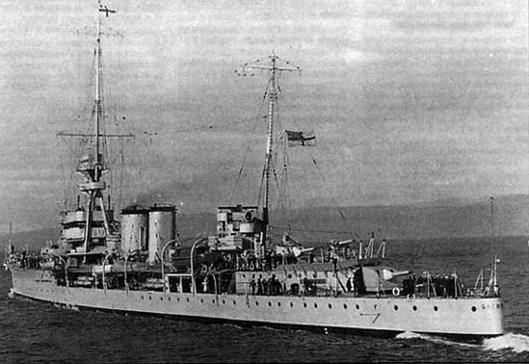
In 1943, Diomed was sent for repairs to the metropolis, where it was decided to convert the cruiser into a training ship. In this role, "Diomed" served until April 1946, after which it was sold for scrap.
In general, the cruisers of the "D" series were late for participation in the First World War, and by the beginning of the Second World War they were completely outdated. However, the resource inherent in the ships allowed them to perform, albeit secondary, but combat roles in naval theater of operations. It turned out to be very good hunters for raiders and transports.
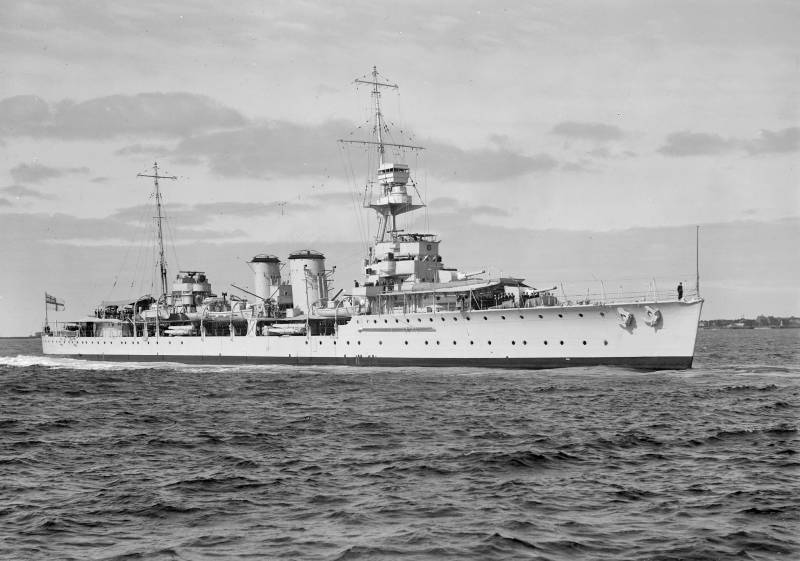
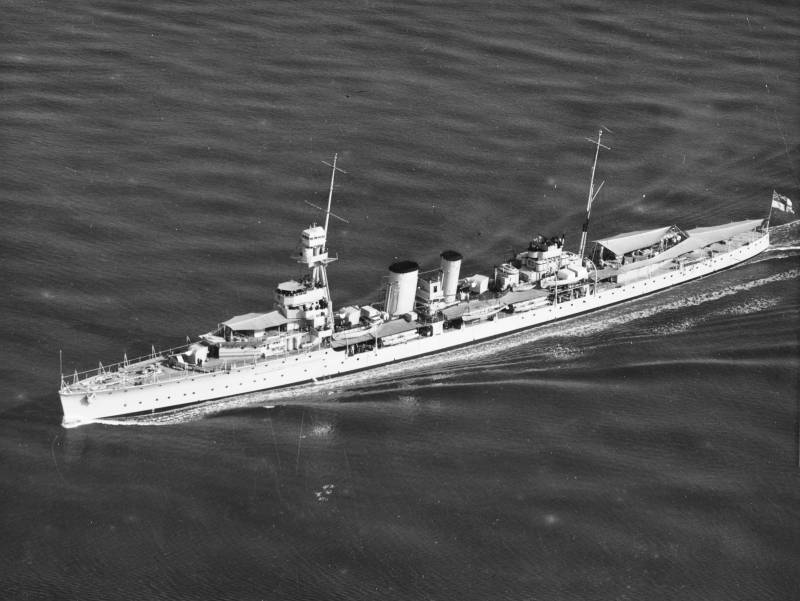
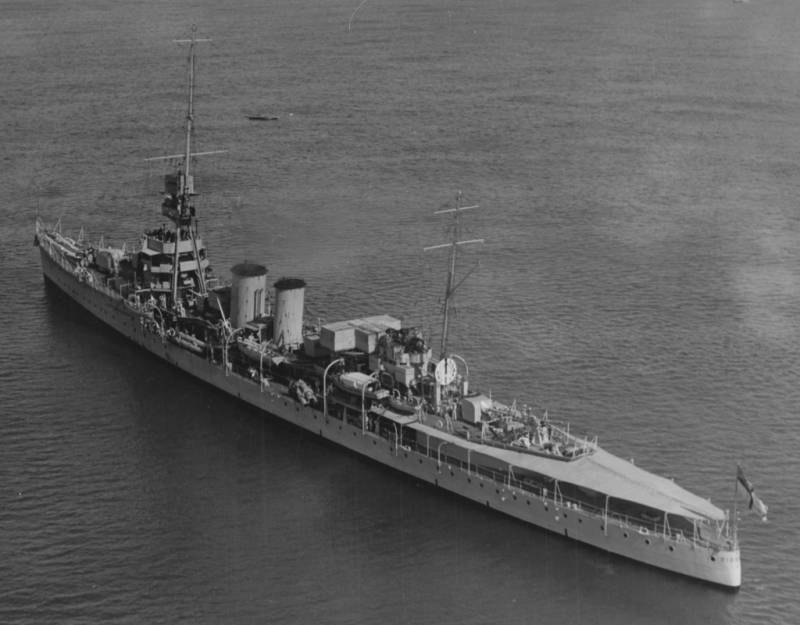
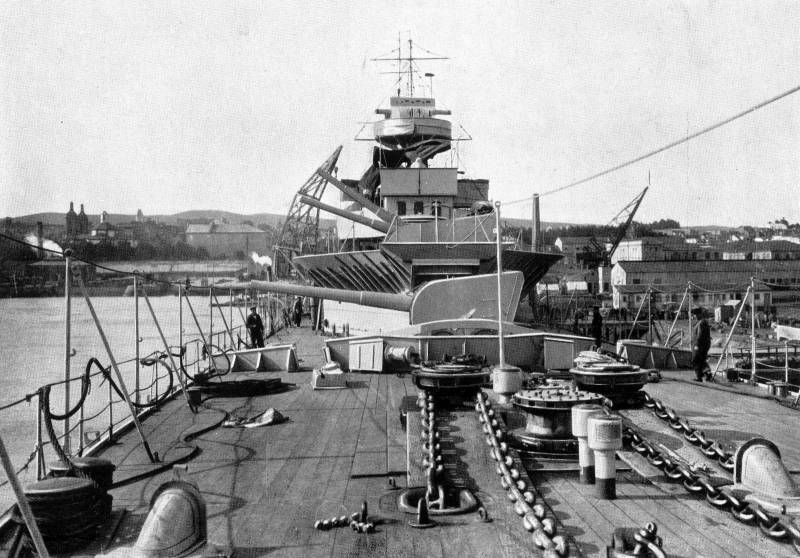
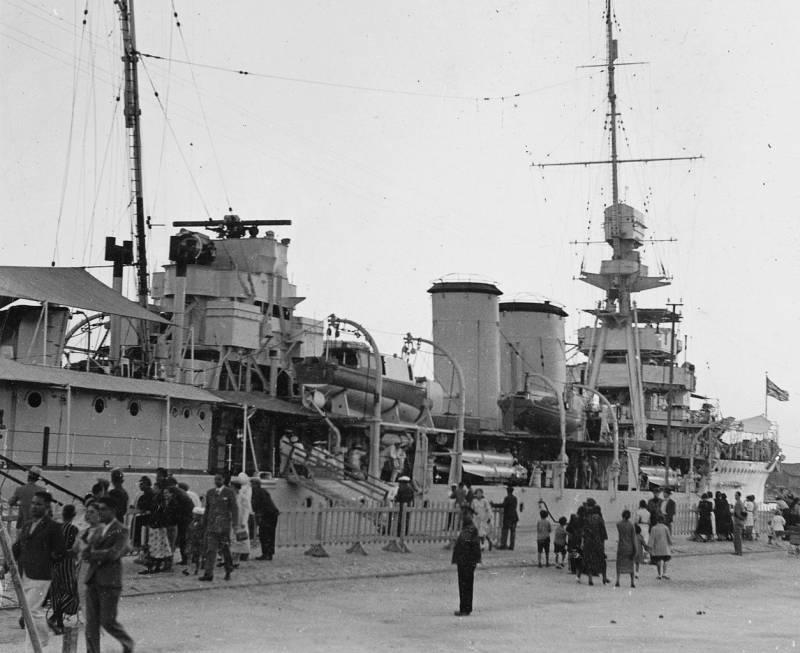
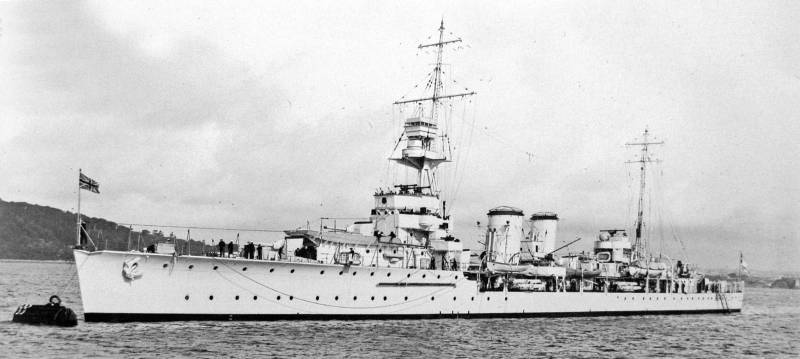
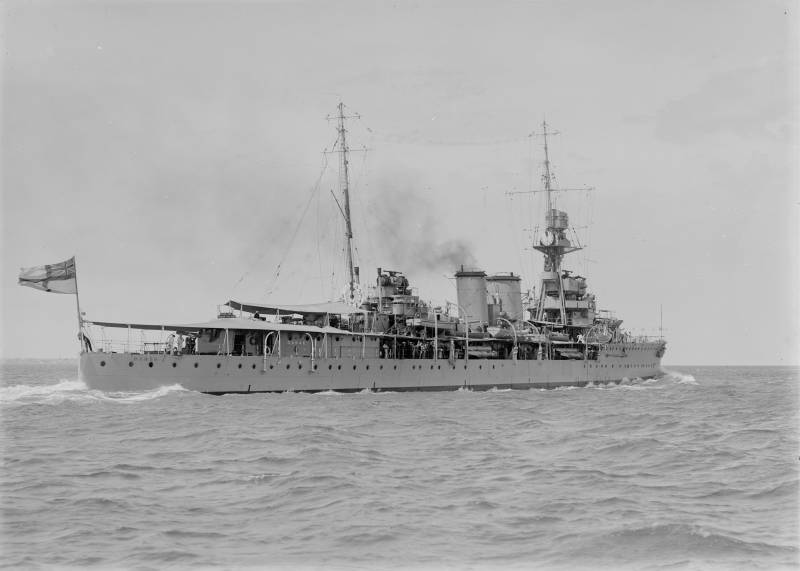
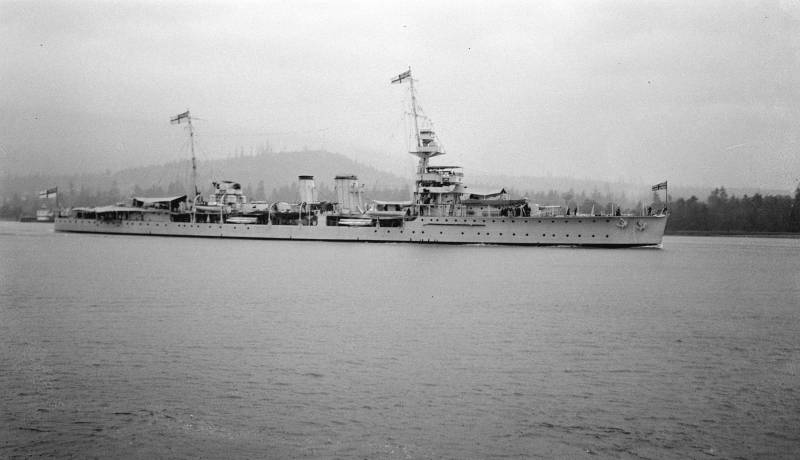
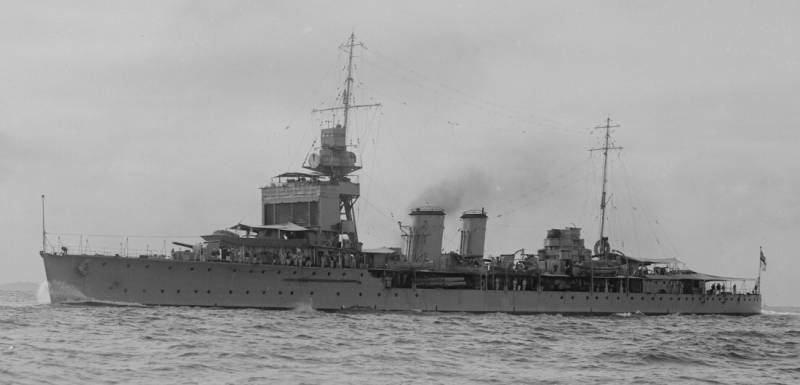
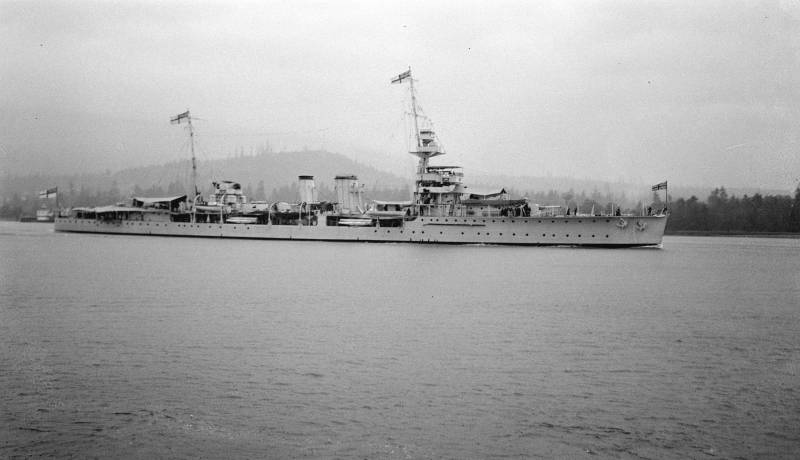
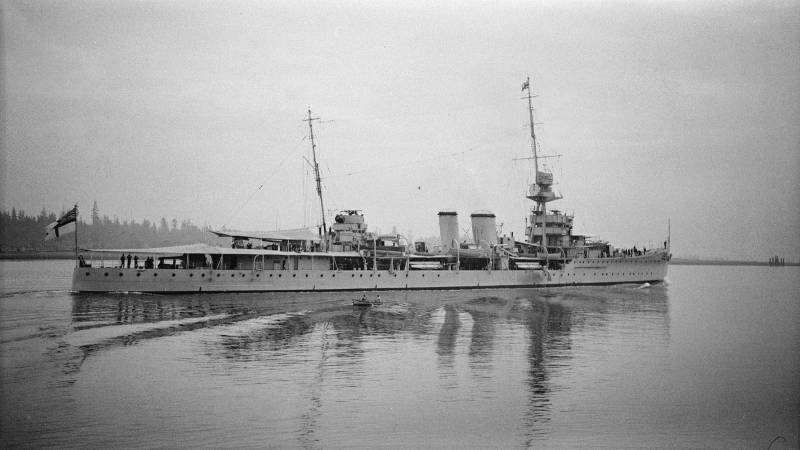
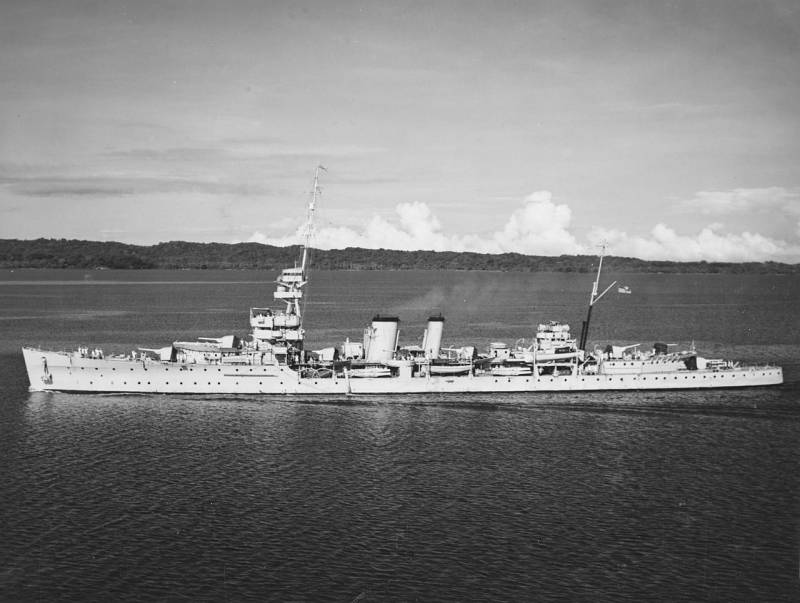
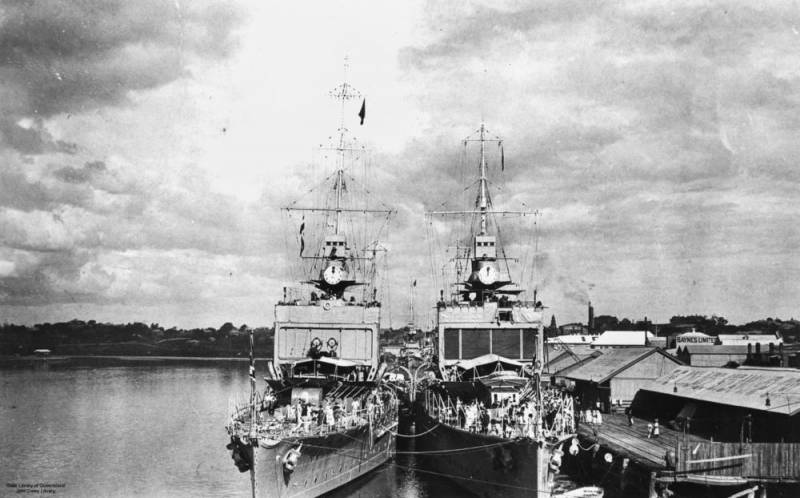
Information